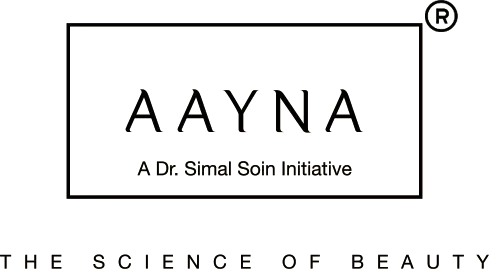People around the world consistently express a wish to maintain clear, spotless, and glowing skin. Black spots on the back and shoulders are one skin issue that can make this challenging to achieve. While black spots are mostly benign; their origins can range from common sunspots to more serious conditions like skin cancer, which may require urgent care. It’s crucial to speak with a dermatologist in Delhi who can identify the reason behind the black spots and recommend the best course of action for eliminating them.
Topical ointments are typically the first line of treatment for hyperpigmentation. But at AAYNA, we provide more than just prescription treatments for black spots. We prioritize identifying the underlying issue. With our clinic’s latest technology, you can treat and eliminate black spots on your skin using the most recent medical advancements.
Black Spots On The Back
Blackheads and black spots on the back and neck are very common problems that affect many people. Numerous issues, such as sun exposure, hormonal changes, acne scars (acne treatment for Indian skin), and skin injuries, can lead to hyperpigmentation.
Furthermore, because of their higher melanin synthesis, those with darker complexions are frequently more prone to hyperpigmentation. Although these spots are typically benign, they can harm one’s self-esteem and confidence, which may lead people to look for efficient treatment methods.
Fortunately, there are many treatments available to help erase dark spots and level out skin tone. Treatments like chemical peels, microdermabrasion, laser therapy, and topical creams containing chemicals like hydroquinone or retinoids. In addition, maintaining smooth, glowing skin on the back and neck may be achieved by implementing a regular skincare regimen, applying sunscreen every day, and refraining from popping or squeezing pimples.
Why Do Black Spots Appear on the Back?
Black patches on the back, often linked to hyperpigmentation, can have several other reasons outside acne.
- Sun Exposure: Extended contact with ultraviolet (UV) radiation can cause the creation of melanin, which can result in the development of dark patches on the back called solar lentigines or sunspots. Check: home remedies for sunspots
- Post-Inflammatory Hyperpigmentation (PIH): As the skin heals, dark areas may remain from prior skin inflammation or damage, such as acne outbreaks, wounds, or skin diseases like psoriasis or eczema.
- Hormonal Changes: Variations in hormone levels, especially in pregnancy, can cause a rise in melanin synthesis, which can lead to the formation of melasma, or dark spots. Check: ways to treat hormonal acne
- Genetic Predisposition: Some people are predisposed to hyperpigmentation, which makes them more prone to dark patches on the back and other areas of the body.
- Friction and Irritation: Particularly in places that are prone to rubbing, persistent friction from garments, backpacks, or other causes of irritation can result in post-inflammatory hyperpigmentation.
- Medication: Hyperpigmentation can occur as a side effect of several medicines, antimalarial treatments, and chemotherapy agents.
- Skin Disorders: As part of its symptomatology, conditions such as lichen planus, lichen simplex chronicus, or allergic responses can generate dark patches on the back.
- Age-related Changes: As people become older, their skin’s capacity to control the synthesis of melanin may diminish. This can result in the development of age spots on the back and other parts of the body exposed to the sun.
Are Over-the-Counter Treatments Effective In Treating Black Spots On The Back?
Over-the-counter products can be effective in treating black spots on the back, giving accessible alternatives for those looking to address hyperpigmentation. Topical creams are common treatments that can gradually lighten dark spots. However, while these treatments may result in some improvement, they might not be as effective or focused as professional treatments.
Professional procedures, such as chemical peels, microdermabrasion, and laser therapy, often provide quicker and more noticeable results by targeting hyperpigmentation more specifically and intensively. Depending on the severity of their condition and their desired results, individuals might consider consulting a dermatologist
to choose the best course of action.
Do Home Remedies Effectively Treat Black Spots On The Back?
Many people turn to home remedies for treating back black spots due to their affordability and perceived natural appeal. While these methods may offer some advantages, it’s crucial to understand their limitations.
Green tea extract, apple cider vinegar, lemon juice, and aloe vera are well known for their potential to soothe damaged skin and lessen hyperpigmentation. These have long been used in remedies due to their calming qualities, and over time, topical treatment can lighten dark spots and even out skin tone.
However, it’s important to recognize that home remedies may not be as consistent or reliable as medical treatments. While some individuals find success with DIY approaches, there’s often limited scientific evidence to support their effectiveness. Additionally, home remedies carry potential risks of allergic reactions or skin irritation. The varying amounts and effectiveness of active ingredients in these treatments can also make it difficult to predict results.
Professional Dermatological Treatments For Black Spots On The Back
While home remedies can offer a starting point, seeking professional guidance from dermatologists or skincare specialists like AAYNA unlocks a world of safe and effective treatments tailored to your individual needs. Expert interventions provide focused strategies for managing hyperpigmentation, with less potential for negative outcomes. Speaking with a medical professional can guarantee the most effective plan of action for getting more even-toned, clearer skin on the back as well as personalized advice.
Professional dermatology procedures for back black spots go beyond a one-size-fits-all approach. Instead, dermatologists create a customized treatment plan to lower melanin synthesis, exfoliation treatments to eliminate surface pigmentation, and skin renewal-promoting procedures.
Dermatologists may prescribe drugs containing chemicals that suppress melanin formation or stimulate skin renewal, offer various procedures to enhance cell turnover and diminish pigmentation, and address melanin in the skin for progressive lightening of dark areas. With continued use, these procedures hope to gradually reduce the appearance of dark spots and restore a more luminous, even skin tone.
Different Treatments For Black Spots on The Back
Several methods are available for treating blackheads on the back, all aiming to reduce hyperpigmentation and achieve a more even, clear complexion. Let’s delve into some popular treatment options:
- Fractional Laser
In fractional laser treatment, certain light beams are directed towards specific parts of the skin using a laser instrument. This process induces regulated micro-injuries in the deeper layers of the skin, therefore inducing collagen formation and facilitating skin rejuvenation. Melanin is another substance that the laser light targets; it breaks down extra pigment to lessen the visibility of black patches. Over several sessions, fractional laser therapy can successfully enhance skin tone and texture with the added benefit of less downtime.
- Chemical Peels
A chemical solution is applied to the skin in a chemical peel, causing the outermost layer to peel and exfoliate. Fresher, brighter skin is revealed below thanks to this technique, which also helps to exfoliate dead skin cells and promote cell turnover. Chemical peels function by encouraging the pigmented cells on the skin to shed, which reduces black spots and evens out the skin tone. The depth of the peel might vary, resulting in superficial, deep, and variable degrees of recovery and effectiveness.
- Q-switched ND YAG Laser
This type of laser targets melanin in the skin by producing extremely brief, high-intensity light pulses that do not harm surrounding tissues. This therapy functions by dissolving the larger melanin particles into smaller pieces, which the body then naturally gets rid of. Recalcitrant pigmentation, such as black areas on the back, responds well to Q-switched ND YAG laser therapy. With many sessions, it can result in noticeable changes in the texture and tone of the skin with little to no downtime.
- Microneedling
Often referred to as collagen induction treatment, microneedling is the process of making tiny punctures on the skin’s surface using a device that contains thin needles. The synthesis of elastin and collagen fibers is sparked by this process, which also activates the skin’s innate healing response. Because microneedling improves general skin texture and stimulates skin renewal, it can help lessen the visibility of black spots. Furthermore, the procedure improves topical skincare products’ ability to tackle pigmentation by improving their absorption.
These all work well for treating black spots on the back and provide different ways to reduce hyperpigmentation and even out skin tone. These treatments are well-liked options for getting softer, more radiant skin since they can be tailored to each patient’s needs and offer obvious results with little downtime.
How AAYNA Can Help You Achieve Clearer Skin?
Our team of professionals at AAYNA is committed to carefully and precisely treating black spots on the back. To provide a customized approach to therapy, we start by doing a comprehensive assessment to determine the underlying reasons for hyperpigmentation.
Our skilled dermatologists target and lessen black spots with precision using cutting-edge methods. To get the best outcomes, we put safety and efficacy first in our individualized treatment programs, which are created to meet each patient’s unique needs.
You can rely on AAYNA to bring back the brightness and self-assurance of your skin, giving you a softer, more even complexion that you’ll be proud to flaunt.







